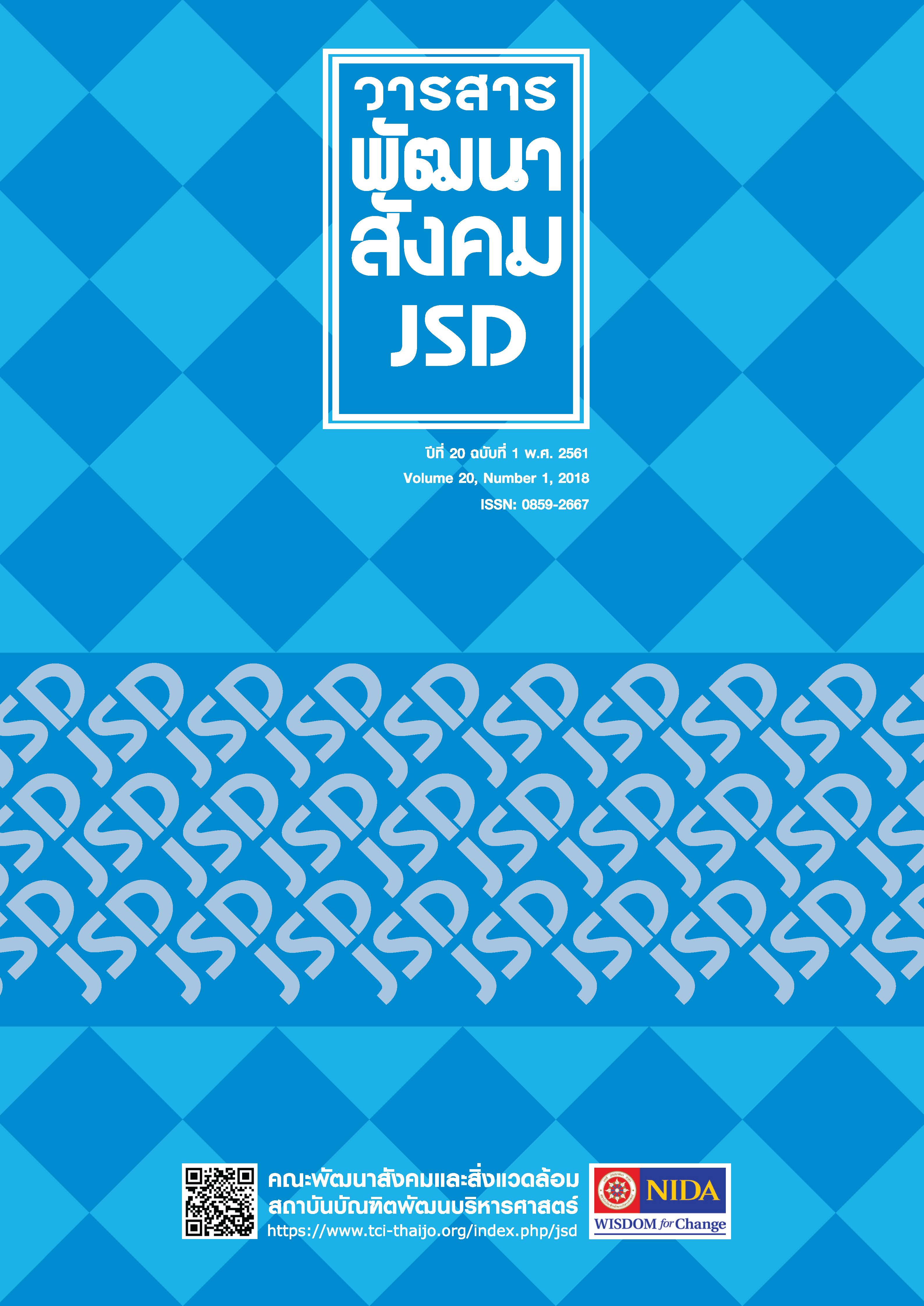Potential Impact of the ASEAN Community on the Ministry of Justice’s Operation
Main Article Content
Abstract
This research focuses on the potential impacts of the ASEAN Community on the Ministry of Justice (MOJ)’s operations. By using the scenario technique TAIDA – standing for tracking, analyzing, imaging, deciding and acting (the scope of this research does not cover the phase of acting) – and qualitative research methods like in-depth interview and focus group, the research found that the ASEAN Community will have both constructive and harmful impacts on the operations of nine departments supervised by the Permanent Secretary of the Ministry of Justice. Two surrounding environments of the Justice Ministry’s operations in the ASEAN Community are: the economic growth without fair distribution the multicultural society in Thailand; and the possibility of more social problems with complexity. There are four desired changes preparing for the arrival of the ASEAN Community: revised and reformed relevant laws and regulations; development of administration; good strategies with professional strategic implementation; and networks at both domestic and international levels.
Article Details
References
2. Albanese, Jay S. 2009. Transnational Crime. Retrieved 20 August 2017 from www. oxfordbibliographiesonline.com/view/document/obo-9780195396607/obo-978 0195396607-0024.xml.
3. ASEAN Secretariat. 2008. ASEAN Charter. Jakarta: ASEAN Secretariat.
4. ASEAN Secretariat. 2008. ASEAN Economic Community Blueprint. Jakarta: ASEAN Secretariat.
5. ASEAN Secretariat. 2009. ASEAN Political-Security Community Blueprint. Jakarta: ASEAN Secretariat.
6. ASEAN Secretariat. 2009. ASEAN Socio-Cultural Community Blueprint. Jakarta: ASEAN Secretariat. ASEAN Secretariat. 2011. Declaration on ASEAN Unity in Cultural Diversity: Towards Strengthening ASEAN Community. Retrieved 20 August 2017 from http://www.asean.org/storage/archive/documents/19th%20summit/Culture.pdf.
7. Beeson, Mark, ed. 2004. Contemporary Southeast Asia: Regional Dynamics, National Differences. New York: Palgrave Macmillan.
8. Boundless. 2016. "A Multicultural Society." Retrieved 20 August 2017 from https://www.boundless.com/sociology/textbooks/boundless-sociology-textboo k/raceand-ethnicity-10/race-and-ethnicity-in-the-u-s-84/a-multicultural-societ y-493-3316/
9. Bryman, Alan, and Burgess, Robert G. eds. 1994. Analyzing Qualitative Data. London: Routledge. Bowles, Paul. 1997. ASEAN, AFTA and the New Regionalism. Pacific Affairs. 70 (Summer): 219 – 233.
10. Corben, Ron. 2015. Trade Liberalization Sparks Fears of Cross-Border Crime Boom. Retrieved 20 August 2017 from https://asia.nikkei.com/Politics-Economy /International-Relations /Trade-liberalization-sparks-fears-of-cross-border-crime-boom.
11. Danupon Ariyasatchakorn and Sompawin Manpasert, 2015. Situation and Impact of Free Flow of Labor in ASEAN Region. Bangkok: [In Thai]. Chulalongkorn University Press.
12. Government Public Relation Department. 2014. Strategies to Prepare Thailand for the ASEAN Community. [In Thai]. Retrieved August 2, 2015 from http://www. thailand.prd.go.th.
13. Hettne, Bjorn and Inotia, Andras. 1994. The New Regionalism: Implications for Global Development and International Security. Helsiki: UNU World Institute for Development Economic Research.
14. Holsti, K.J. 1995. International Politics: a Framework for Analysis 7th. Englewood Cliffs, New Jersey: Prentice-Hall Inc.
15. ISEAS. 2010. Know Your ASEAN 2nd. Chiang Mai: silkworm Books.
16. Jones, Water S. 1991. The Logic of international Relations. 7th ed. New York: Harper Collins Publishers.
17. Keohane, Robert O. 1991. Cooperation and International Regimes. In Little, Richard and Smith, Michael eds.. Perspective on World Politics. London: Routledge.
18. Klockar. 1997. Quoted in Taylor, Steven J., and Bogdan, Robert. 1984. Introduction to Qualitative Research Methods: the Searching for Meaning. New York: John Wiley & Sons.
19. Krueger, Richard A. and Casey, Mary Anne. 2000. Focus Groups. A Practical Guide for Applied Research (3rd Ed.). Thousand Oaks, CA: Sage Publications.
20. Kulwadee Charoensri. 2008. Multicultural Society in Thailand (2). Retrieved 20 August 2017 from http://oknation.nationtv.tv/blog/KrueOon
21. Lindgren, Mats and Bandhold, Hans. 2003. Scenario Planning: The Link Between Future and Strategy. Hampshire: Palgrave Macmillan.
22. Little, Richard, and Smith, Michael, eds. 1991. Perspectives on World Politics. London: Routledge.
23. Lusk, Sean and Birks, Nick. 2014. Rethinking Public Strategy. Hampshire: Palgrave Macmillan.
24. Makinda, Samuel M. 1998. Globalization as a Policy Outcome. Current Affairs Bullintin. 72 (April – May): 4-10.
25. Milner, Helen V. 1997. Interests, Institutions, and Information: Domestic Politics and International Relations. Princeton, New Jersey: Princeton University Press.
26. Ministry of Justice. 2012. Ministry of Justices Annual Report of 2012. Bangkok: Ministry of Justices.
27. Nafziger, Wayne E. 1997. The Economics of Developing Countries 3rd ed. New Jersey: PrenticeHall International, Inc.
28. National Economic and Social Development Board. 2013. Report on the Analysis of Poverty and Inequality in Thailand in 2011. Retrieved on 20 August 2017 from http://social.nesdb.go.th/social/Portals/O/Documents.
29. Office of the Special Envoy on Transnational Crime. 2017. Transnational Crime. Retrieved 20 August 2017 from www.osetc.gov.ph/index.php/transnational-crimes.
30. Policy and Strategy Office, the Office of the Permanent Secretary of Justice Ministry. 2012. Strategic Plan and Action Plan of the Ministry of Justices for the Arrival of ASEAN Community (2013 – 2015). Unpublished paper.
31. Pornthep Channik. 2014. ASEAN Security. Bangkok: [In Thai]. A-S Printing Techniques.
32. Sumonthip Jitsawang and Piyaporn Tannikun. 2013. Juvenile Justice System in ASEAN. Retrieved 2 March 2015 from http://www.djop.go.th/images/djopi mage/AEC-djop1.pdf.
33. Suvicha Pouaree. 2001. Domestic Influences Affecting Thailand’s Foreign Economic Cooperation Policy: A Case study on AFTA. Doctoral Dissertation, [In Thai]. National Institute of Development Administration.
34. Taylor, Steven J., and Bogdan, Robert. 1984. Introduction to Qualitative Research Methods: the Searching for Meaning. New York: John Wiley & Sons.
35. Un Sovannasam. 2011. “ASEAN Efforts in Dealing with Transnational Crime” in Yoong, Yoong Lee. Eds. 2011. ASEAN Matters: Reflecting on the Association of Southeast Asian Nations. Singapore: World Scientific Publishing.
36. Weatherbee, Donald E. 2005. International Relations in Southeast Asia: The Struggle for Autonomy. Lanham, MD: Rowman & Littlefield Publishers, Inc.
37. White, Brian; Little, Richard; and Smith, Michael. 1997. Issues in World Politics. New York: St. Martin’s Press.
38. Wikipedia. 2016. Bangkok Rules. Retrieved 20 August 2017 from https://en.wiki pedia.org/ wiki/Bangkok_Rules
39. Yoong, Yoong Lee. Eds. 2011. ASEAN Matters: Reflecting on the Association of Southeast Asian Nations. Singapore: World Scientific Publishing.
40. Yoshimatsu, Hidetaka. 2006. Collective Action Problems and Regional Integration in ASEAN. Contemporary Southeast Asia. 28 (1): 115 – 140.

